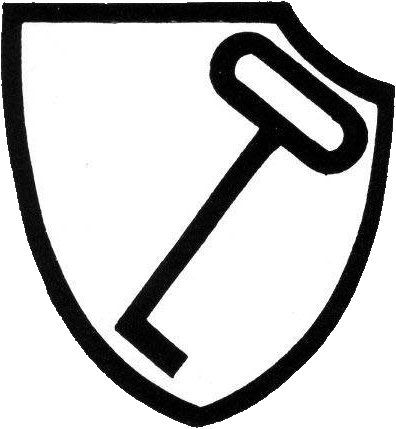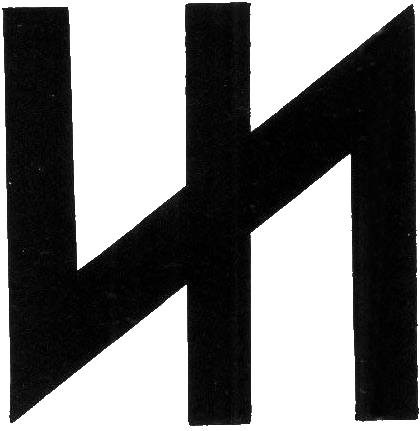
ROBERT C. STERN, illustrated by DON GREER and RON VOLSTAD
SS ARMOR. A Pictorial History of the Armored Formations of the Waffen-SS
The lull that followed the successful containment of the first Russian counteroffensive brings to a close the first hectic period of Waffen-SS development. Starting this period with a strength of three loosely connected standarten, the Waffen SS had grown to a nominal complement of six divisions [SS-Division "Nord" being added in early 1941, never fully motorized] and a brigade, while a seventh division [Freiwilligen-Gebirgs-Division, later to become Prinz Eugen] was forming. Four of the divisions were motorized, but not one of them was at strength and LAH and Reich in particular had been decimated in the Winter fighting. The time had come for the units of the Waffen-SS to begin their next transformation.

The SS drives into France, mounted on Kfz 15 Mercedes-Benz 230 medium cars. Above can be seen a lineup of Leibstandarte 230s, each towing a trailer.

A similar column of SS-V vehicles is halted in the center of a French town. The two lead cars are 230s, but the two visible to the right are Kfz 15 Horch medium cross-country cars each towing a 7.5 cm IIG 18 Infantry Gun. [Bundesarchiv]


LAH. "Dietrich" [Key]

An interesting shot of Leibstandarte motorcyclists showing the beginnings of the unit's insignia. Barely visible on the front fender of the righthand BMW R75 is the key symbol that would become associated with LAH. The key was chosen in honor of the regiment's commander Josef "Sepp" Dietrich [dietrich is the German word for key]. The diversity in Leibstandarte markings during the French Campaign reflects in part some of the suppression seen during the Polish Campaign and in part the fact that these markings appear to have evolved from the bottom up rather than having been decreed by regimental command. Also the markings that were used varied considerably from the key alone to a key inside a narrow tilted shield as seen on some Pkws. [Scott Van Ness]

Three views of the motorized troops of SS-V in France.
Four members of Headquarters SS-Standarte Deutschland are seen here riding in a Kfz 15 Mercedes-Benz 230 decorated with a swastika on the hood for air recognition. The soldiers are wearing transitional style uniforms. Three wear the costly, early Dark Green collared feldbluse, while the driver wears the later all Field Grey model. Note that none have collar insignia, as during this period the old style "SS1" collar tabs of Deutschland were being suppressed in favor of the universal "SS" pattern, though the lack of rank tab on the left collar is harder to explain. The regiment can still be identified, however, by the cufftitles visible on the nearer soldiers. [National Archives]

Three troopers also from Deutschland [they still have the "SS1" collar tabs] wearily sitting in a 230 halted by the side of the road, pass the time reading. As opposed to the HQ troops above, these are combat soldiers and wear the camouflage smock over their feldbluse and cover for the helmet. [Bundesarchiv]

The inevitable end result of mobile warfare, exhaustion overtakes two Sanis [Sanitäter = Corpsman] of the Pioneer Battalion.


An SdKfz 231 eight wheel armored car of Leibstandarte passes through a Southern French town toward the end of the campaign. At this stage there was great variation in the marking of LAH vehicles. The outline cross having been dropped, the only visible insignia on this particular vehicle is the tactical sign. [National Archives]

A column of vehicles of the regimental staff of SS-Standarte Deutschland is seen halted by a railroad crossing on the road to Libourne, near Bordeaux. Many SS-V vehicles carried a large white numeral next to the tactical sign indicating position in the unit. [National Archives]

The French Campaign completed, SS-V was earmarked for Operation "Sealion", the proposed invasion of England. Here a Kfz 15 Horch signals car practices disembarkation from a landing barge, bearing the same style markings carried during the just completed campaign.


Between the French and Balkans Campaigns, Leibstandarte became the first SS unit to acquire heavy armored vehicles with the addition of a Sturgeschütz Abteilung. Two StuG III ausf Bs of that unit showing some of the rapidly evolving markings displayed by LAH vehicles. The key without a shield appears here on the rear plate of the vehicle. Also on the rear of the vehicle are a dog's head symbol and a circle-dot insignia which is repeated on the front superstructure. A narrow White outline cross is seen on the side. [National Archives]

Two civilian pattern vehicles are seen here, pressed directly into service for Leibstandarte.
A lineup of Chevrolet cars is seen halted by the side of a country road in France. The only concession to the military on these vehicles has been the painting out of the headlights. These vehicles carry another LAH marking, the White key in a faintly visible Black outline shield. There appears to be a tactical sign and small vehicle number on the opposite fender. [National Archives]

A Ford G917T three ton truck is passing between two girls distributing the local military newspaper in Bulgaria, where LAH is preparing for the Balkans Campaign. Like the previous shot, the vehicle has the Black outline shield - White key divisional marking, above which is the vehicle number. [Bundesarchiv]

Two more views of SS vehicles moving into position prior to the Balkans Campaign.
Reich, after going through considerable reorganization from SS-V, was sent to Rumania for final training before the invasion of Yugoslavia. Here a BMW R75 of the Auf-Abt passes in front of a line of curious Rumanian police. Of interest is the emergence of the divisional insignia, the so-called Kampfrune on the side of the sidecar.

Displaying no visible marks besides the license plate, an SdKfz 220 four wheel armored car of LAH drives through Southern Bulgaria. The vehicles has been covered with a specially fitted tarpaulin cover and has had custommade "spaced armor" added onto the front. [Bundesarchiv]


One of Reich's original vehicles [as can be ascertained from the four-digit license number], a Kfz 15 Horch, is being passed by a column of Yugoslav prisoners during that division's brief participation in the Balkan Campaign. Of note is the small bundle of sticks tied to the front bumper in case mud is encountered.

Three recon vehicles of Leibstandarte are seen here on a road in Greece, being passed by civilians moving in the opposite direction. To the left is "Laforce", the same SdKfz 231 eight wheel armored car previously seen in Prague. Behind it is an SdKfz 232 radio car, and in the foreground an SdKfz 221 with the "field-fit" spaced armor. [National Archives]

Seen at Patras, having crossed over to the Peloponnesus, a line up of LAH motorcycles passes a group of Greek civilians. These vehicles carry the vertical White shield and key marking that developed from the previous Black and White emblem.


Two shots of LAH armor during Barbarossa, the invasion of Russia.
The StuG-Abt pauses outside Mariupol in Southern Russia. PzJg Is have been added to give the armored unit some anti-tank capability. Note that all three visible armored vehicles carry the same dog's head insignia of the StuG-Abt., first seen in France.

Another shot from the same roll shows the next vehicle, displaying a nearly obscured outline cross, vehicle number and shield and key insignia. Note the shield now has the characteristic "cutout" in the upper right corner.

"Sepp" Dietrich, the legendary [and notorious] commander of Leibstandarte is seen here in full dress, carrying the rank of SS-Obergruppenführer, early in the Russian Campaign. [Bundesarchiv]

LAH


Four views of Wiking, the new SS division, to be first blooded during Barbarossa.
An SdKfz 232 eight wheel radio car carrying only a Yellow divisional marking, the so-called Sun-wheel, a variant on the swastika, is seen here against the background of the open spaces of Southern Russia. [Bundesarchiv]

An SdKfz 221 four-wheeled armored car carries a couple of extra grenadiers as passengers as it heads into a Russian city. The tactical sign indicates that this vehicles belongs to Wiking's Auf-Abt.

A BMW of Wiking is being pushed across a stream by its driver, passenger and a civilian helper. The letter "K" on the sidecar indicates Wiking's affiliation with von Kleist's Panzer-Gruppe in Southern Russia. Note the driver has a very non-regulation kerchief around his neck in an effort to keep out the all pervasive dust. [Bundesarchiv]

Felix Steiner, the well respected commander of Wiking is seen in the foreground with an aide, poring over the seemingly endless maps of Russia.

Appearing almost identical to those seen during the Balkans campaign, this Reich BMW R75 motolcycle of the Auf-Abt Stafl [St = Stab = Staff] halts briefly outside a burning Russian town.

Reich

An SdKfz 10 one ton halftrack of Reich is seen being followed by a Krupp Protz L2H143 gun tractor Kfz 69, more commonly known as Boxer. The White "G" indicates that Reich was part of Guderian's 2. Panzer-Gruppe. The use of a Wehrmacht vehicle, without bothering to change the license numbers, indicates the haste with which the establishments of the SS divisions had been increased between campaigns.

With Winter approaching, Reich found itself facing Moscow in Fall 1941. This well known shot deserves repetition because it shows a fairly rare vehicle interestingly marked and SS-Obergruppenführer Paul Hausser, the retired Army General who created the Waffen-SS and was conceded to be by far its ablest commander. The vehicle in which he is standing is an SdKfz 253 IGepBeokw observation halftrack.

Two shots of Totenkopf's war in North Russia.
Two motorcycles take a brief respite from the dust of a Russian Summer, being passed by a truckful of troops. Of interest is the difference in the Death's Head marking between vehicles, a "common" shape not being found until the next year. Also note the red and white stop disc in the center of the lorry's tailgate, an early form of convoy spacing indicator. [National Archives]

A Kfz 15 Adler 3Gd of Totenkopf's Field Artillery Battalion has managed to get itself mired in the sand. The trooper has not appeared to have had too much success in getting his car unstuck. He will probably have to wait for a hitch from a halftrack. [Bundesarchiv]

Not reaching divisional status for another year, the SS-Kavallerie Brigade was mainly employed behind the lines clearing up pockets of resistance. Though mainly horsed, the brigade did have mechanized elements. The tactical sign on the bow plate is too obscured to determine which part of the brigade this SdKfz 222 belongs. Inexplicably missing its 2 cm main armament, it has an MP 40 pushed through the driver's right front visor opening for added firepower. [Bundesarchiv]

Operation Typhoon, the drive on Moscow, was halted twice, first by mud and then by cold.
The German Army was adequately prepared for neither. Two medium passenger cars of Reich are seen in the mud that could frequently mire cars axle-deep. On the left is a Kfz 15 Mercedes-Benz 230, to the right a Adler 3Gd Kubel. The divisional insignia is in Yellow, making it appear much fainter than the White G and convoy stripes. [National Archives]

The first snow catches German formations without camouflage or cold weather gear. These Reich motorcyclists already look cold in their motoring coats and extreme weather was still several weeks off. The unexpectedly early Winter was equally hard on equipment and men, halting Reich within reach of the Kremlin. The lineup of PzKpfw IIIs probably are those of 10. Pz-Div., alongside of which Reich fought for most of Typhoon.


Having spent the Winter involved in the bloody fighting around Demyansk, Spring brought Totenkopf some much needed rest and a chance to prepare for a quieter Summer between Lake Seliger and Lake Ilmen.
An SdKfz 9 Famo 18 ton halftrack is seen among the pines. [Bundesarchiv]

In a rare idyllic moment on the Eastern Front. Three Totenkopf troopers, two wearing shorts, are washing the Spring mud and Winter camouflage off their trucks. [Bundesarchiv]

Immediately prior to being sent to France for a much needed refit, this SdKfz 250/11 ISPW light armored personnel carrier of LAH is seen in position in a South Russian cow pasture. The 250/11 was a recon company leader's vehicle mounting the squeezebore 2.8 cm schwere Panzerbüsche 41 light antitank gun. Note the rather casual attempt at natural camouflage by draping a few clumps of straw over the fenders of the vehicle. [National Archives]

A far cry from the Eastern Front, a lineup of three civilian style cars of Leibstandarte's war correspondant troop are halted by the side of the road while the occupants admire the scenery in sunny France. The wreath of leaves around the shield and key divisional insignia is in honor of the award of the oak leaves to the Knight's Cross to "Sepp" Dietrich. This style of unit marking was carried by LAH vehicles during its stay in France, Summer 1942. Each car also carries the KB [Kriegsberichter] insignia of the war correspondant. [Bundesarchiv]
We have much more interesting information on this site.
Click MENU to check it out!
∎ cartalana.com© 2009-2025 ∎ mailto: cartalana@cartalana.com